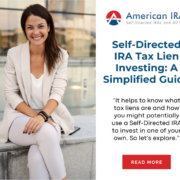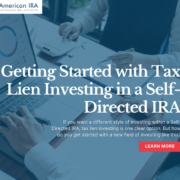Are There Limits to Self-Directed IRA Tax Lien Investing?
When you first discover Tax Lien Investing it can be common to get excited about the possibilities. High rates of return with interest rates. The possibility of foreclosing on a home if everything doesn’t go well, which gives you an “out” by turning the tax lien into a piece of real property. But are there limits to Self-Directed IRA Tax Lien Investing you’ll want to know about? Here’s what you should consider if you’re thinking about using a Self-Directed IRA to hold this type of asset.
Maximum Rates on Tax Liens, State by State
The first limit of which you’ll need to be aware: the fact that maximum interest rates on the tax liens can vary by state. For example, the rates allowed in Florida may not be the same as the rates allowed in Arizona, or vice versa. For some investors, this can be a bit of good news, particularly if they live in a state which allows high annual returns from tax liens. In other states, you may find that the maximum rates aren’t quite what you hoped for.
This isn’t always a deal breaker, but it’s something that you need to be aware of: there are caps to the rates of return on a tax lien, which does lock them in a bit. However, these returns also have the possibility of serving as a good hedge against returns in other asset classes. As always, determining what’s right for a retirement portfolio is up to the Self-Directed IRA investor.
Using the Property in the Tax Lien
You may know the underlying property in a tax lien can potentially revert to you in the event of a foreclosure. You can then choose to sell the property for profit and/or hold the property for the income that the rent generates. However, because you purchased this property within a Self-Directed IRA, you’ll have to be aware of the central limitations that come with using this property. The property is technically an investment on behalf of your IRA, meaning that it’s designated a retirement asset. It’s not one that you can exploit for personal use, such as living in it or renting it out to someone you are related to, also known as a “disqualified person.”
You’ll have to keep it separate from the rest of your investments, working through the Self-Directed IRA vehicle (and your Self-Directed IRA custodian) to ensure that you keep in accordance with retirement regulations. Failure to do so could result in tax penalties and hefty fines.
Relying on Professionals
It may be tempting to read these limits and believe that you have Tax Lien Investing figured out. But it can be a complicated asset. That’s why we recommend a good rule of thumb: in all cases, it’s a good idea to consult with professionals. For example, you may consult with a realtor and/or appraiser to assess the value of the property before bidding on the tax lien. Or you may consult with an attorney who understands tax lien law in your state, as not all states are the same. You may also consult with a tax advisor on your specific retirement investing situation.
American IRA is a Self-Directed IRA administration firm, but we don’t offer advice on specific investments. Nor are we financial advisors. We can help administer a Self-Directed IRA, however, which can mean making purchases on behalf of the IRA that you ultimately direct.
Interested in learning more about Self-Directed IRAs? Contact American IRA, LLC at 866-7500-IRA (472) for a free consultation. Download our free guides or visit us online at www.AmericanIRA.com.






